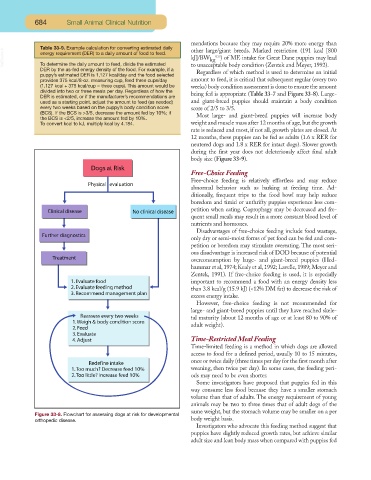Page 661 - Small Animal Clinical Nutrition 5th Edition
P. 661
684 Small Animal Clinical Nutrition
mendations because they may require 20% more energy than
Table 33-9. Example calculation for converting estimated daily other large/giant breeds. Marked restriction (191 kcal [800
VetBooks.ir energy requirement (DER) to a daily amount of food to feed. kJ]/BW kg 0.75 ) of ME intake for Great Dane puppies may lead
To determine the daily amount to feed, divide the estimated
DER by the as-fed energy density of the food. For example, if a to unacceptable body condition (Zentek and Meyer, 1992).
puppy’s estimated DER is 1,127 kcal/day and the food selected Regardless of which method is used to determine an initial
provides 375 kcal/8-oz. measuring cup, feed three cups/day amount to feed, it is critical that subsequent regular (every two
(1,127 kcal ÷ 375 kcal/cup = three cups). This amount would be weeks) body condition assessment is done to ensure the amount
divided into two or three meals per day. Regardless of how the
DER is estimated, or if the manufacturer’s recommendations are being fed is appropriate (Table 33-7 and Figure 33-8). Large-
used as a starting point, adjust the amount to feed (as needed) and giant-breed puppies should maintain a body condition
every two weeks based on the puppy’s body condition score score of 2/5 to 3/5.
(BCS). If the BCS is >3/5, decrease the amount fed by 10%; if
the BCS is <2/5, increase the amount fed by 10%. Most large- and giant-breed puppies will increase body
To convert kcal to kJ, multiply kcal by 4.184. weight and muscle mass after 12 months of age, but the growth
rate is reduced and most, if not all, growth plates are closed. At
12 months, these puppies can be fed as adults (1.6 x RER for
neutered dogs and 1.8 x RER for intact dogs). Slower growth
during the first year does not deleteriously affect final adult
body size (Figure 33-9).
Free-Choice Feeding
Free-choice feeding is relatively effortless and may reduce
abnormal behavior such as barking at feeding time. Ad-
ditionally, frequent trips to the food bowl may help reduce
boredom and timid or unthrifty puppies experience less com-
petition when eating. Coprophagy may be decreased and fre-
quent small meals may result in a more constant blood level of
nutrients and hormones.
Disadvantages of free-choice feeding include food wastage,
only dry or semi-moist forms of pet food can be fed and com-
petition or boredom may stimulate overeating. The most seri-
ous disadvantage is increased risk of DOD because of potential
overconsumption by large- and giant-breed puppies (Hed-
hammar et al, 1974; Kealy et al, 1992; Lavelle, 1989; Meyer and
Zentek, 1991). If free-choice feeding is used, it is especially
important to recommend a food with an energy density less
than 3.8 kcal/g (15.9 kJ) (<12% DM fat) to decrease the risk of
excess energy intake.
However, free-choice feeding is not recommended for
large- and giant-breed puppies until they have reached skele-
tal maturity (about 12 months of age or at least 80 to 90% of
adult weight).
Time-Restricted Meal Feeding
Time-limited feeding is a method in which dogs are allowed
access to food for a defined period, usually 10 to 15 minutes,
once or twice daily (three times per day for the first month after
weaning, then twice per day). In some cases, the feeding peri-
ods may need to be even shorter.
Some investigators have proposed that puppies fed in this
way consume less food because they have a smaller stomach
volume than that of adults. The energy requirement of young
animals may be two to three times that of adult dogs of the
same weight, but the stomach volume may be smaller on a per
Figure 33-8. Flowchart for assessing dogs at risk for developmental
orthopedic disease. body weight basis.
Investigators who advocate this feeding method suggest that
puppies have slightly reduced growth rates, but achieve similar
adult size and lean body mass when compared with puppies fed

